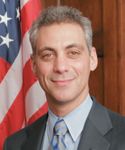Opinion: Are Price Controls the New Black?
Pharmaceutical Executive
In march, us rep. rahm "Mr. Television" Emanuel (D-IL) reintroduced legislation aimed at what he calls "driving down the price of prescription drugs." But the only thing such legislation would accomplish would be the "driving down" of pharmaceutical innovation.
In march, us rep. rahm "Mr. Television" Emanuel (D-IL) reintroduced legislation aimed at what he calls "driving down the price of prescription drugs." But the only thing such legislation would accomplish would be the "driving down" of pharmaceutical innovation.

Peter Pitts
The Newspeak-named Pharmaceutical Market Access and Drug Safety Act has been kicking around Congress for several years with considerable bipartisan backing. Emanuel and friends have just taken the same old drug-importation song and dance, tweaked it with new safety (non)solutions, and dressed it up in this season's fashionable pricing rhetoric.
The bill's authors promise to "insure" the safety of imported medicines by "strictly limiting" the nations they come from. But consider the following facts:Because of parallel trade (or "re-importation"), more than 20 percent of all drugs sold in Britain come from places like Greece, Portugal, Latvia, Estonia, Malta, and Cyprus. Trade laws prohibit manufacturers from managing their European supply chains in their own or patients' interests. Last year, 140 million individual drug packages were parallel-imported in the European Union, and a secondary wholesaler literally opened the packages, removed the contents, and repackaged each and every one.
Of course, these parallel profiteers are in the money-making business, not the drug-safety business. And mistakes happen. New labels incorrectly state the dosage strength, the expiration date and batch numbers on the boxes don't match those of the medicines inside, and patient information materials are in the wrong language or out-of-date."Guaranteeing safety," as the bill's backer crow? Hardly.
But that's not the only danger. According to Emanuel, the legislation will "allow American consumers, pharmacists, and wholesalers access to FDA-approved prescription drugs at world-market prices." Otherwise known as "reference pricing," this is a system practiced in the European Union and Canada that compares the prices of drugs among a number of developed nations and then chooses an average, or reference, price. In other words, if we import prescription meds at foreign prices, we will, sooner or later, also import foreign price controls.

Rep. Rahm Emanuel: The New Man from Illinois
But call it "world pricing," and that's another story—all fair and square, right? Well, not when you consider that the reason these nations get away with reference pricing is that they threaten pharmaceutical companies with patent expropriation if they don't knuckle under to the dictated terms. These nations all say that prices are negotiated with pharmaceutical firms, but that's just not so. It's not even a take-it-or-leave-it proposition. It's a take-it-or-we'll-take-it-from-you shakedown.
If the Europeans and Canadians can dictate prices, why shouldn't we do the same? Because the prices Americans pay for medicines—which, according to the bill, are 35 to 55 percent higher than in the rest of the developed world—fuel global R&D. Reference-pricing schemes allow other nations if not a free ride, then a highly subsidized one, on the backs of the American healthcare consumer. And they don't even say thank you.
So what would happen if the United States signed on to world pricing? For one thing, 21st-century pharmaceutical R&D would grind to a halt for lack of funds. Just recently the Government Accountability Office reported that pharma's annual R&D spending increased 147 percent, to $60 billion, between 1993 and 2004. At the same time, the number of new drug applications to FDA grew by only 38 percent—and only one-third of those were for new drugs offering true innovations.
What Mr. Emanuel and friends don't understand is that drug development is ever more complex and costly as we move from small to large molecules and begin to aggressively research practical and personalized applications of the human genome. The question that the New Man from Illinois's rhetoric begs is: Are we willing to trade tomorrow's new cures and treatments for world prices today? That's what will happen if we allow reference pricing for prescription medicines to be Rahmed down our throats.

Addressing Disparities in Psoriasis Trials: Takeda's Strategies for Inclusivity in Clinical Research
April 14th 2025LaShell Robinson, Head of Global Feasibility and Trial Equity at Takeda, speaks about the company's strategies to engage patients in underrepresented populations in its phase III psoriasis trials.
Beyond the Prescription: Pharma's Role in Digital Health Conversations
April 1st 2025Join us for an insightful conversation with Jennifer Harakal, Head of Regulatory Affairs at Canopy Life Sciences, as we unpack the evolving intersection of social media and healthcare decisions. Discover how pharmaceutical companies can navigate regulatory challenges while meaningfully engaging with consumers in digital spaces. Jennifer shares expert strategies for responsible marketing, working with influencers, and creating educational content that bridges the gap between patients and healthcare providers. A must-listen for pharma marketers looking to build trust and compliance in today's social media landscape.